Themed collection ChemComm contributions to the United Nations Sustainable Development Goals

Emerging covalent triazine framework-based nanomaterials for electrochemical energy storage and conversion
This review introduces recent advances of covalent triazine framework-based materials for electrochemical energy storage and conversion, including supercapacitors, alkali-ion batteries, lithium–sulfur batteries, HER, ORR/OER, and carbon dioxide reduction reaction.

Chem. Commun., 2023,59, 6314-6334
https://doi.org/10.1039/D3CC00712J
Precise modulation strategies of 2D/3D perovskite heterojunctions in efficient and stable solar cells
We summarize various effective methods for controlling the film thickness and structural phases in 2D/3D perovskite heterojunction structures and discuss possible solutions to improve the performance of perovskite devices.

Chem. Commun., 2023,59, 4128-4141
https://doi.org/10.1039/D2CC07048K
Recent advances and challenges in developing electrochemiluminescence biosensors for health analysis
Recent advances and challenges in developing electrochemiluminescence biosensors for health analysis are reviewed.

Chem. Commun., 2023,59, 3507-3522
https://doi.org/10.1039/D2CC06930J
Fluorescence, ultrasonic and photoacoustic imaging for analysis and diagnosis of diseases
This feature article focuses on introducing three kinds of non-invasive imaging technology, i.e., fluorescence, ultrasonic and photoacoustic imaging, in which optical and/or acoustic signals are employed for diagnosing various diseases.

Chem. Commun., 2023,59, 2399-2412
https://doi.org/10.1039/D2CC06654H
Porous metal–organic frameworks for hydrogen storage
This article reviews the recent progress in the use of metal–organic frameworks as solid absorbents for hydrogen storage, and their current challenges and future prospects.
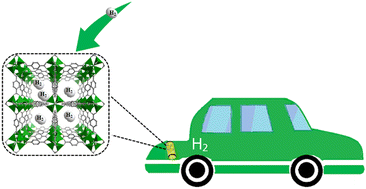
Chem. Commun., 2022,58, 11059-11078
https://doi.org/10.1039/D2CC04036K
Multi-functional metal–organic frameworks for detection and removal of water pollutions
This feature article reviews the recent achievements in metal–organic frameworks (MOFs) as versatile advanced materials for multifunctional water treatment and prospects the current challenges and the future research trends.
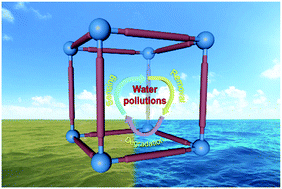
Chem. Commun., 2022,58, 7890-7908
https://doi.org/10.1039/D2CC02738K
Supramolecular cancer photoimmunotherapy based on precise peptide self-assembly design
Combinational photoimmunotherapy (PIT) is considered to be an ideal strategy for the treatment of malignant cancer, because it can ablate the primary tumor and induce the host immune response to control tumor growth and distal metastasis.

Chem. Commun., 2022,58, 2247-2258
https://doi.org/10.1039/D1CC06355C
The advent and development of organophotoredox catalysis
We herein discuss how and when organic photocatalysts can efficiently replace or outperform their metal counterparts.

Chem. Commun., 2022,58, 1263-1283
https://doi.org/10.1039/D1CC05850A
Electrochemical detection of heavy metal ions in water
Electrochemical sensors demonstrate outstanding performance at detecting heavy metal ions, with a high specific surface area and high sensitivity which can excellently complete the on-site detection of trace heavy metal ions in water.

Chem. Commun., 2021,57, 7215-7231
https://doi.org/10.1039/D1CC00983D
Wearable triboelectric nanogenerators for heart rate monitoring
Triboelectric nanogenerator emerges as a cost-effective biotechnology that could convert the subtle skin deformation caused by arterial pressure fluctuation into high voltage output, creating electrical signals with an extremely high signal-to-noise ratio for high-fidelity continuous pulse waveform monitoring.

Chem. Commun., 2021,57, 5871-5879
https://doi.org/10.1039/D1CC02091A
Recent advances in perovskite oxides as electrode materials for supercapacitors
This review summaries recent progress of perovskite oxides toward supercapacitor applications. Optimization strategies are also discussed.

Chem. Commun., 2021,57, 2343-2355
https://doi.org/10.1039/D0CC07970G
Designing high performance conjugated materials for photovoltaic cells with the aid of intramolecular noncovalent interactions
This review summarizes the recent progress in high performance photovoltaic materials with the aid of intramolecular noncovalent interactions.

Chem. Commun., 2021,57, 302-314
https://doi.org/10.1039/D0CC07086F
Continuous flow chemistry: where are we now? Recent applications, challenges and limitations
A general outlook of the changing face of chemical synthesis is provided in this article through recent applications of continuous flow processing in both industry and academia.
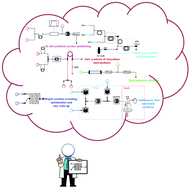
Chem. Commun., 2018,54, 13894-13928
https://doi.org/10.1039/C8CC07427E
Electrocatalytic reforming of waste plastics into high value-added chemicals and hydrogen fuel
We report an electroreforming strategy to upcycle waste PET into value-added chemicals and H2 using Pd as the anode and Ni foam as the cathode.
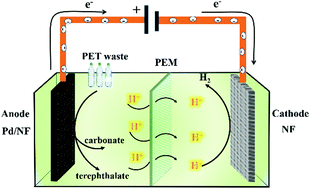
Chem. Commun., 2021,57, 12595-12598
https://doi.org/10.1039/D1CC05032J
CRISPR/Cas12a-mediated gold nanoparticle aggregation for colorimetric detection of SARS-CoV-2
The trans-cleavage activity of the target-activated CRISPR/Cas12a liberated an RNA crosslinker from a molecular transducer, which facilitated the assembly of gold nanoparticles.

Chem. Commun., 2021,57, 6871-6874
https://doi.org/10.1039/D1CC02546E
A first new porous d–p HMOF material with multiple active sites for excellent CO2 capture and catalysis
A first new porous d–p HMOF has been yielded by the monometallic MOF as the precursor. The results of the gas sorption and CO2 cycloaddition indicate that this work may supply an effective approach to obtain new functional HMOF materials.
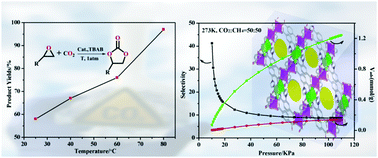
Chem. Commun., 2020,56, 2395-2398
https://doi.org/10.1039/C9CC09664G
A tripeptide-based self-shrinking hydrogel for waste-water treatment: removal of toxic organic dyes and lead (Pb2+) ions
A tripeptide-based supramolecular automatically self-shrinking superhydrogel has been discovered for the efficient removal of toxic organic dyes and Pb2+ ions from waste-water.
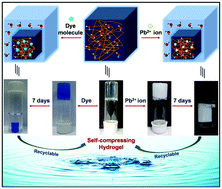
Chem. Commun., 2017,53, 5910-5913
https://doi.org/10.1039/C7CC01774J
Fenton's reagent for the rapid and efficient isolation of microplastics from wastewater
Fenton's reagent is a very useful preparation method for the efficient and bias-free analysis of microplastics. The catalytic reaction did not affect microplastics chemistry or size, offering a simple, high-speed and low-cost method for processing microplastics present in wastewater or other complex media.
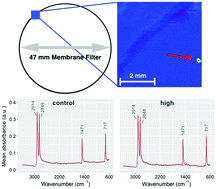
Chem. Commun., 2017,53, 372-375
https://doi.org/10.1039/C6CC08798A
Highly-efficient dye-sensitized solar cells with collaborative sensitization by silyl-anchor and carboxy-anchor dyes
A collaborative sensitization by silyl-anchor and carboxy-anchor dyes (ADEKA-1 + LEG4) in dye-sensitized solar cells realized a high light-to-electric energy conversion efficiency of over 14% under one sun illumination.
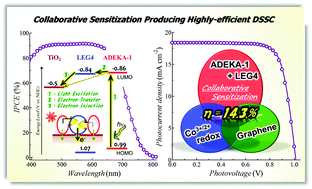
Chem. Commun., 2015,51, 15894-15897
https://doi.org/10.1039/C5CC06759F
A new aluminium-ion battery with high voltage, high safety and low cost
A new aluminium-ion battery with high voltage, high safety and low cost, which might light the future.

Chem. Commun., 2015,51, 11892-11895
https://doi.org/10.1039/C5CC00542F
NZVI modified magnetic filter paper with high redox and catalytic activities for advanced water treatment technologies
The in situ synthesis and applications of zero-valent-iron nanoparticles entrapped in filter paper as reactive membranes for bioremediation and catalysis.
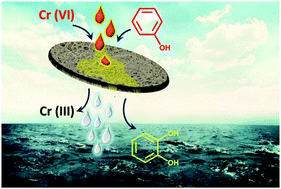
Chem. Commun., 2014,50, 15673-15676
https://doi.org/10.1039/C4CC06241H
An achievement of over 12 percent efficiency in an organic dye-sensitized solar cell
Dye-sensitized solar cells fabricated by using a novel metal-free alkoxysilyl carbazole dye and a Co3+/2+-complex redox electrolyte exhibited light-to-electric energy conversion efficiencies of up to 12.5% under the one sun condition.
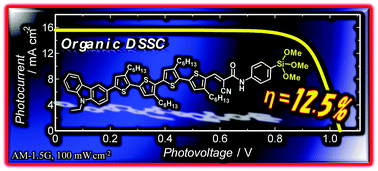
Chem. Commun., 2014,50, 6379-6381
https://doi.org/10.1039/C4CC02192D
Bay-linked perylene bisimides as promising non-fullerene acceptors for organic solar cells
A series of bay-linked perylene bisimides with the different degrees of twisting and flexibility are promising as non-fullerene acceptors for organic solar cells.
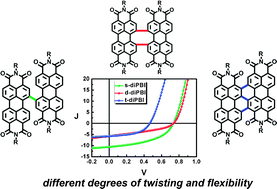
Chem. Commun., 2014,50, 1024-1026
https://doi.org/10.1039/C3CC47204C
Novel, electrolyte solutions comprising fully inorganic salts with high anodic stability for rechargeable magnesium batteries
Herein the first inorganic magnesium salt solution capable of highly reversible magnesium electrodeposition is presented.
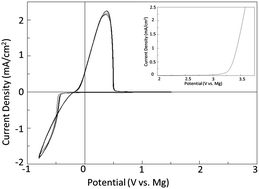
Chem. Commun., 2014,50, 243-245
https://doi.org/10.1039/C3CC47896C
Drug delivery by a self-assembled DNA tetrahedron for overcoming drug resistance in breast cancer cells
A DNA tetrahedron is employed for efficient delivery of doxorubicin into drug-resistant breast cancer cells.
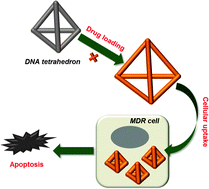
Chem. Commun., 2013,49, 2010-2012
https://doi.org/10.1039/C3CC38693G
A high energy-density tin anode for rechargeable magnesium-ion batteries
A high energy-density insertion-type Sn anode is considered for use in rechargeable Mg-ion batteries, using conventional battery electrolytes.
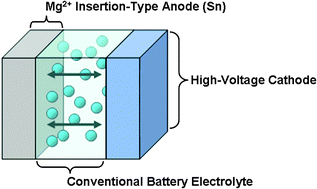
Chem. Commun., 2013,49, 149-151
https://doi.org/10.1039/C2CC34673G
Hierarchical NiCo2O4@MnO2 core–shell heterostructured nanowire arrays on Ni foam as high-performance supercapacitor electrodes
An advanced integrated electrode obtained by directly growing hierarchical NiCo2O4@MnO2 core–shell heterostructured nanowire arrays on nickel foam exhibits improved supercapacitive performance.
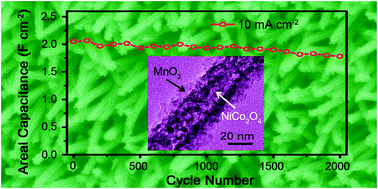
Chem. Commun., 2013,49, 137-139
https://doi.org/10.1039/C2CC37117K
Superhydrophobic and superoleophilic hybrid foam of graphene and carbon nanotube for selective removal of oils or organic solvents from the surface of water
3D graphene–CNT hybrid foam can selectively remove oils and organic solvents from water with high absorption capacity and good recyclability.
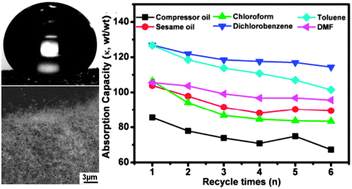
Chem. Commun., 2012,48, 10660-10662
https://doi.org/10.1039/C2CC35844A
High capacity Na-storage and superior cyclability of nanocomposite Sb/C anode for Na-ion batteries
A nanocomposite Sb/C material can deliver its theoretical 3 Na storage capacity reversibly with a strong rate capability and a long-term cycling stability, offering practical feasibility as a high capacity and cycling-stable alloy anode for room temperature Na-ion batteries.
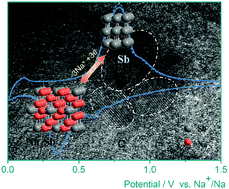
Chem. Commun., 2012,48, 7070-7072
https://doi.org/10.1039/C2CC32730A
Prussian blue: a new framework of electrode materials for sodium batteries
Prussian blue and its analogues consisting of different transition-metal ions (Fe, Mn, Ni, Cu, Co and Zn) have been synthesized at room temperature.
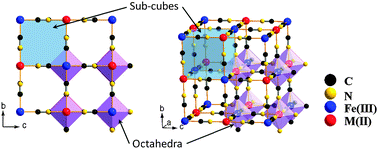
Chem. Commun., 2012,48, 6544-6546
https://doi.org/10.1039/C2CC31777J
Facile synthesis of silicon nanoparticles inserted into graphene sheets as improved anode materials for lithium-ion batteries
A novel method for inserting Si nanoparticles into graphene sheets has been realized by combining freeze-drying and thermal reduction.

Chem. Commun., 2012,48, 2198-2200
https://doi.org/10.1039/C2CC17061B
The rechargeable aluminum-ion battery
We report the first example of an Al-ion rechargeable battery comprised of a metallic aluminium anode and a V2O5 nano-wire cathode in an ionic liquid electrolyte.

Chem. Commun., 2011,47, 12610-12612
https://doi.org/10.1039/C1CC15779E
In situ ion exchange synthesis of the novel Ag/AgBr/BiOBr hybrid with highly efficient decontamination of pollutants
Ag/AgBr/BiOBr hybrid was synthesized through in situ ion exchange reaction followed by photoreduction, which displayed superior visible light photocatalytic activities.

Chem. Commun., 2011,47, 7054-7056
https://doi.org/10.1039/C1CC11525A
Functionalized carbon nanomaterials as nanocarriers for loading and delivery of a poorly water-soluble anticancer drug : a comparative study
The drug loading capacity and the cytotoxicity of CPT-loaded CNT- and GO-based nanocarriers are originally investigated.
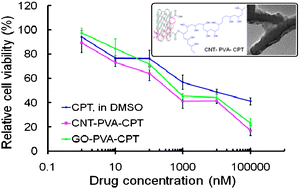
Chem. Commun., 2011,47, 5235-5237
https://doi.org/10.1039/C1CC00075F
In situ synthesis of MoS2/graphene nanosheet composites with extraordinarily high electrochemical performance for lithium ion batteries
These MoS2/GNS composites by an in situ solution-phase method exhibit extraordinary capacity, i.e., up to 1300 mA h g−1, and excellent rate capability and cycling stability for LIB.

Chem. Commun., 2011,47, 4252-4254
https://doi.org/10.1039/C1CC10631G
Coordination polymer particles as potential drug delivery systems
Micro- and nanoscale coordination polymer particles can be used for encapsulating and delivering drugs. These results open up new avenues for metal–organic capsules to be used as potential drug delivery systems.

Chem. Commun., 2010,46, 4737-4739
https://doi.org/10.1039/C003084H
Silicon nanoparticles –graphene paper composites for Li ion battery anodes
Composites of Si nanoparticles highly dispersed between graphene sheets, and supported by a 3-D network of graphite formed by reconstituting regions of graphene stacks exhibit high Li ion storage capacities and cycling stability.

Chem. Commun., 2010,46, 2025-2027
https://doi.org/10.1039/B919738A
Superior stability and high capacity of restacked molybdenum disulfide as anode material for lithium ion batteries
Restacked MoS2 with enlarged c lattice parameter and surface area was prepared by exfoliation and restacking process, exhibiting high reversible lithium storage capacity and superior rate capability as anode material for lithium ion batteries.

Chem. Commun., 2010,46, 1106-1108
https://doi.org/10.1039/B920277C
Facile synthesis of carbon-decorated single-crystalline Fe3O4 nanowires and their application as high performance anode in lithium ion batteries
A facile microwave-hydrothermal approach has been used to synthesize single-crystalline Fe3O4 nanowires within 15 min at 150 °C. The Fe3O4 nanowires, after decorating with carbon, exhibit excellent cyclability and rate performance when employed as an anode in lithium batteries.
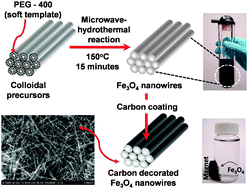
Chem. Commun., 2009, 7360-7362
https://doi.org/10.1039/B916376J
Urea electrolysis: direct hydrogen production from urine
A new technology has been developed that accomplishes the direct conversion of urine and urea to pure hydrogen via electrochemical oxidation with an inexpensive nickel catalyst.

Chem. Commun., 2009, 4859-4861
https://doi.org/10.1039/B905974A
Disulfide-cross-linked PEG-poly(amino acid)s copolymer micelles for glutathione-mediated intracellular drug delivery
Biocompatible, cell-permeable shell cross-linked polymer micelles bearing glutathione-cleavable shell cross-links have been developed for highly effective intracellular delivery of an anticancer drug.

Chem. Commun., 2008, 6570-6572
https://doi.org/10.1039/B815918A
Multiwalled carbon nanotube –doxorubicin supramolecular complexes for cancer therapeutics
Multiwalled carbon nanotube aqueous dispersions using block copolymers are able to form supramolecular complexes with the aromatic chromophore and anticancer agent doxorubicin via π–π stacking and enhance its cytotoxic activity.
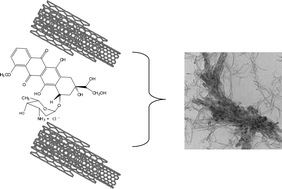
Chem. Commun., 2008, 459-461
https://doi.org/10.1039/B712350G
A highly efficient organic sensitizer for dye -sensitized solar cells
A π-conjugated dye with donor–acceptor moieties exhibited high efficiency for a dye-sensitized solar cell.

Chem. Commun., 2007, 4887-4889
https://doi.org/10.1039/B709859F
A novel organic chromophore for dye -sensitized nanostructured solar cells
A new organic dye with an effective intramolecular charge separation has been synthesized. The overall solar-to-energy conversion efficiency is very promising and the high extinction coefficient together with the triarylamine donor group makes the dye particularly interesting for future use in solid state devices.

Chem. Commun., 2006, 2245-2247
https://doi.org/10.1039/B603002E
Silver nanoparticles fabricated in Hepes buffer exhibit cytoprotective activities toward HIV-1 infected cells
Silver nanoparticles fabricated in Hepes buffer exhibit potent cytoprotective and post-infected anti-HIV-1 activities toward Hut/CCR5 cells.
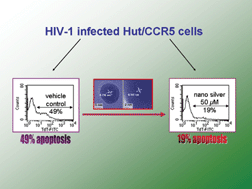
Chem. Commun., 2005, 5059-5061
https://doi.org/10.1039/B510984A
Photocatalytic overall water splitting under visible light by TaON and WO3 with an IO3−/I− shuttle redox mediator
The oxynitride TaON was applied for the first time to the two-step overall splitting of water under visible light through combination with WO3 using an IO3−/I− shuttle redox mediator.
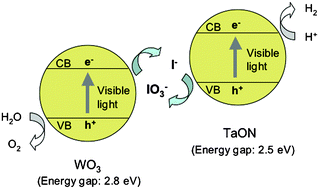
Chem. Commun., 2005, 3829-3831
https://doi.org/10.1039/B505646B
Gold(III) porphyrins as a new class of anticancer drugs : cytotoxicity, DNA binding and induction of apoptosis in human cervix epitheloid cancer cells
A series of gold(III) tetraarylporphyrins are stable in the presence of glutathione and exert much higher potency than cisplatin in killing human cancer cells, including drug-resistant variants; the gold-induced cytotoxicity occurs through apoptotic pathway according to laser confocal microscopy and flow cytometric studies.
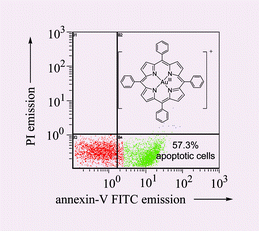
Chem. Commun., 2003, 1718-1719
https://doi.org/10.1039/B303294A
Slow charge recombination in dye -sensitised solar cells (DSSC) using Al2O3 coated nanoporous TiO2 films
The conformal growth of an overlayer of Al2O3 on a nanocrystalline TiO2 film is shown to result in a 4-fold retardation of interfacial charge recombination, and a 30% improvement in photovoltaic device efficiency.

Chem. Commun., 2002, 1464-1465
https://doi.org/10.1039/B202515A
Continuous green biocatalytic processes using ionic liquids and supercritical carbon dioxide
A continuous green biocatalysis process by using a lipase immobilized in ionic liquid to synthesize esters in supercritical carbon dioxide at extreme conditions (100 °C, 150 bar) is described.

Chem. Commun., 2002, 692-693
https://doi.org/10.1039/B200055E
Deep desulfurization of diesel
Chem. Commun., 2001, 2494-2495
https://doi.org/10.1039/B108411A
Aggregation-induced emission of 1-methyl-1,2,3,4,5-pentaphenylsilole
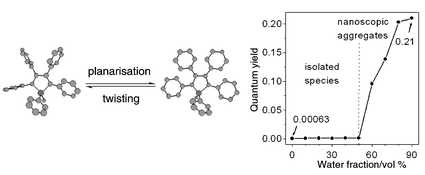
Chem. Commun., 2001, 1740-1741
https://doi.org/10.1039/B105159H
[Ru(η6-p-cymene)Cl2 (pta)] (pta = 1,3,5-triaza-7-phosphatricyclo- [3.3.1.1]decane): a water soluble compound that exhibits pH dependent DNA binding providing selectivity for diseased cells
Chem. Commun., 2001, 1396-1397
https://doi.org/10.1039/B104021A
A
Chem. Commun., 2001, 569-570
https://doi.org/10.1039/B010058G
Opportunities for ionic liquids in recovery of biofuels
Chem. Commun., 2001, 295-296
https://doi.org/10.1039/B006102F
First report of phase selective
Chem. Commun., 2001, 185-186
https://doi.org/10.1039/B007848O
Cu2O: a catalyst for the photochemical decomposition of water?
Cu2O as a photocatalyst for overall water splitting under visible light irradiation
Room temperature ionic liquids as novel media for ‘clean’ liquid–liquid extraction
Friedel–Crafts reactions in room temperature ionic liquids
Production of H2 and CO from liquid water and carbon using solar energy
About this collection
Chemical Communications will be publishing its 60th volume in 2024. Over the past 60 years, ChemComm has been the RSC’s most cited journal, and one of the most trusted venues for rapid publication of short communications. In our anniversary year, we recognise the important contributions ChemComm has made, and continues to make, in advancing the chemical sciences.
This collection brings together historic work and more recent reviews published in ChemComm which demonstrate how chemistry can contribute to the United Nation’s 17 Sustainable Development Goals with the aim of ending poverty, improving health and education, all while tackling climate change and working to preserve our natural environment. Please join us in recognising the important contributions to sustainability that ChemComm’s authors have made over the years.